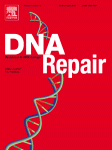
Source
Department of Molecular Biology, Ruđer Bošković Institute, Zagreb, Croatia.
Abstract
Deinococcus radiodurans is one of the most radiation-resistant organisms known. It can repair hundreds of radiation-induced double-strand DNA breaks without loss of viability. Genome reassembly in heavily irradiated D. radiodurans is considered to be an error-free process since no genome rearrangements were detected after post-irradiation repair. Here, we describe for the first time conditions that frequently cause erroneous chromosomal assemblies. Gross chromosomal rearrangements have been detected in recA mutant cells that survived exposure to 5kGy γ-radiation. The recA mutants are prone also to spontaneous DNA rearrangements during normal exponential growth. Some insertion sequences have been identified as dispersed genomic homology blocks that can mediate DNA rearrangements. Whereas the wild-type D. radiodurans appears to repair accurately its genome shattered by 5kGy γ-radiation, extremely high γ-doses, e.g., 25kGy, produce frequent genome rearrangements among survivors. Our results show that the RecA protein is quintessential for the fidelity of repair of both spontaneous and γ-radiation-induced DNA breaks and, consequently, for genome stability in D. radiodurans. The mechanisms of decreased genome stability in the absence of RecA are discussed.
Copyright © 2010 Elsevier B.V. All rights reserved.
- PMID:
- 20817622
- [PubMed - indexed for MEDLINE]
- PDF format soon - Past Research under construction

